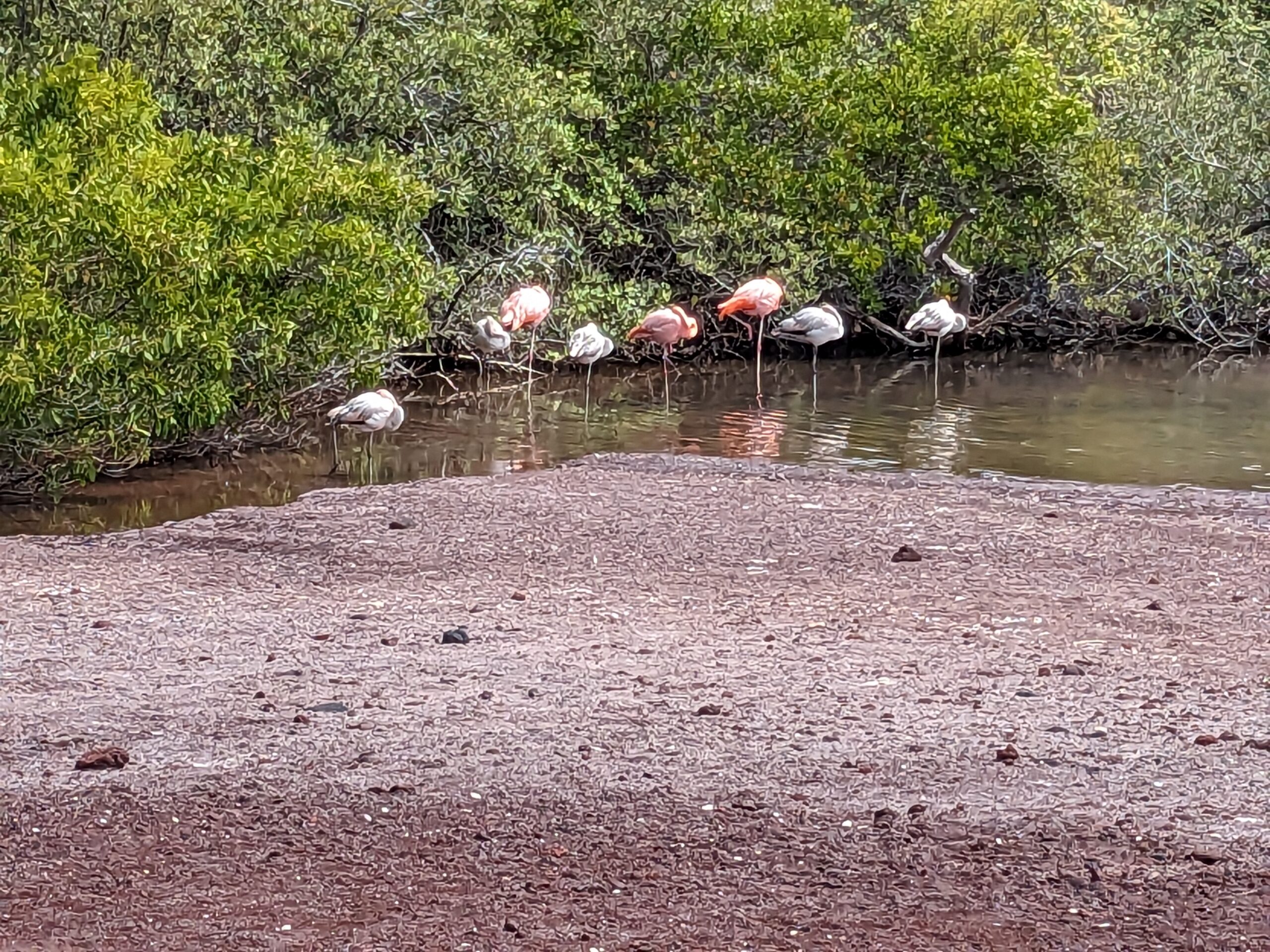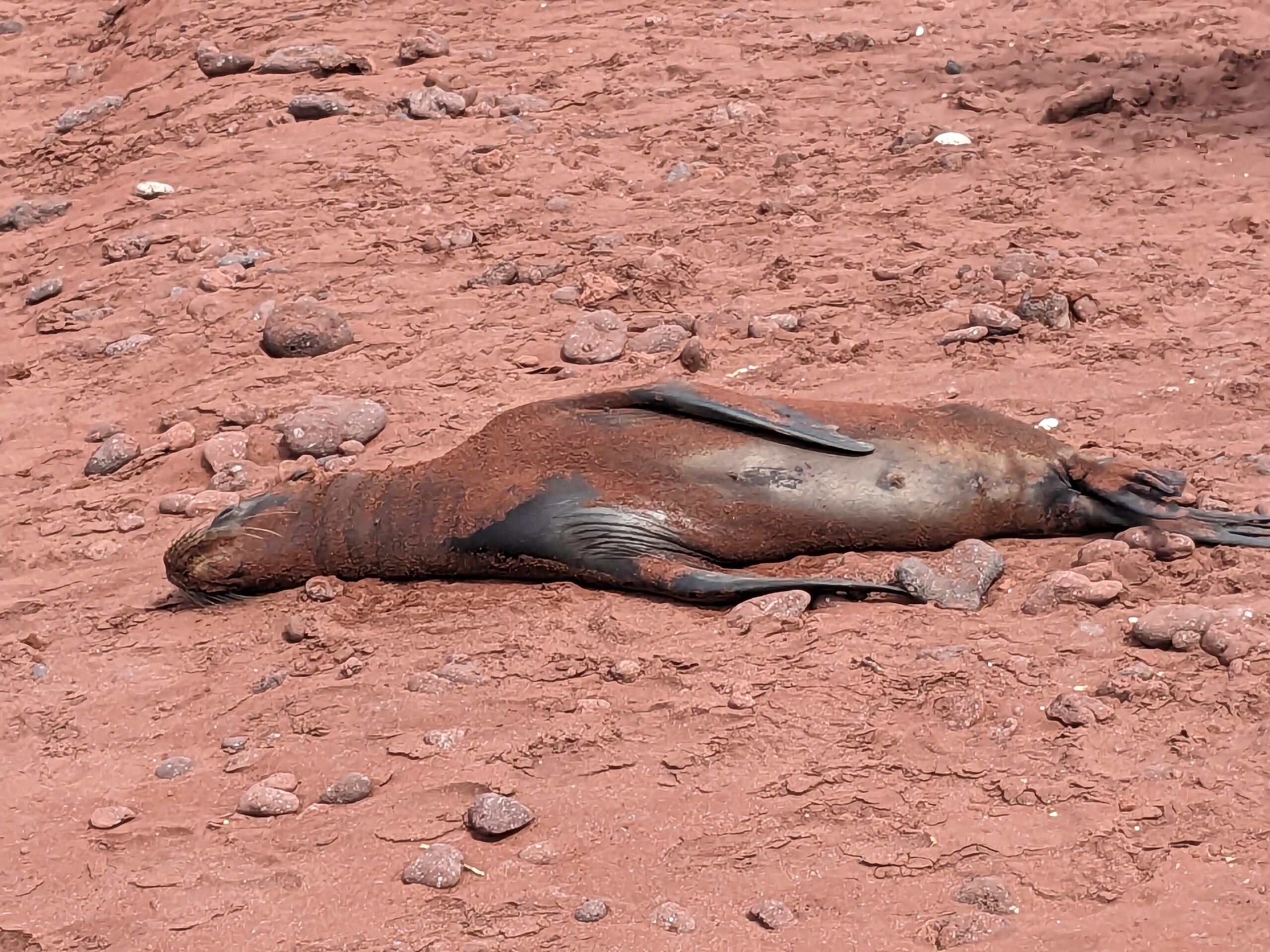
A partial photo of a Galapagos Giant Tortoise.At about 7:50 last night, our boat took off for today’s tour of Isabela Island, the largest island in The Galapagos archipelago. The crew mentioned there would be rough seas, and our fantastic hotel manager, Agustin, passed around seasick pills at dinner, which we declined, never thinking we’d need them.

Before our departure, Agustin and several other staff members mentioned the importance of us staying on the main deck, which we’re on, until heading to bed. This didn’t worry us since we’ve never been sick on our 34 past cruises since we began our journey 11 years ago.

Well, last night, we were in for a big surprise. We didn’t start feeling it until we went to bed, and boom! It hit us both like a ton of bricks! Oh, my gosh, we were seasick for the first time in our lives! Even Tom, who’s tough and resilient, ended up puking his guts out. I held my mouth shut tight and managed to make it through without doing the same. At 1:30 am, when we’d reached our destination and the anchor was lowered, we could both get some sleep.

Tom felt much better after his “event,” but I struggled until we finally anchored, and when I awoke this morning, I was still queasy; I had a hard time getting showered and dressed in the still-rocking catamaran. I couldn’t join Tom and our shipmates for breakfast, but now, close to lunchtime, I am ready to eat something and hope eating helps settle my stomach.

I felt much better after a wonderful lunch of fresh-caught grouper right from the Galapagos waters, roasted chicken, spinach, and salads. After lunch, we took a short nap before Tom headed out again for another tour with the group at 3:00 pm, returning to the ship by 6:00 pm. One of the outstanding naturalists, Orlando, added me to his WhatsApp account and is sending me photos and videos from snorkeling and land sightings. Soon, I will share some of those photos. Otherwise, today’s photos were all taken by Tom. He is doing such a great job!

We could post photos for weeks, but I’m sure most of our readers don’t mind when it’s been a photo drought from us for many months, except for those in August on the Norway and Greenland cruises. We are so excited going forward to be able to share photos of our upcoming extra months spent in Ecuador, a land of many wonders.

In doing online research, I encountered the following from this website about interesting facts about The Galapagos Islands. In future posts, we will share more. See below:
Six hundred miles off the coast of Ecuador lies the Galápagos Archipelago: a world unto itself, forged of lava and isolated for thousands of years. The islands are known for their famously fearless wildlife and as a source of inspiration for Darwin’s theory of evolution. And that’s just part of the story.

Born of fire: The Galápagos Archipelago is one of the most volcanically active areas in the world. Situated atop a hotspot in the western Pacific, the islands were created over millennia of volcanic activity, as magma repeatedly broke through the sea floor and formed layer upon layer of rock, eventually becoming islands. Today, there are 13 active volcanoes in the archipelago, with intermittent eruptions occurring as recently as 2018.

Discovery by accident: The first-recorded visitor to the Galápagos was Tomás de Berlanga, a Spanish noble and the bishop of Panama, whose ship was blown off course in 1535 while sailing from Panama to Peru. Berlanga was less than impressed with the stark, desert-like archipelago, describing it in a letter to the king of Spain as “dross, worthless, because it has not the power of raising a little grass, but only some thistles.”

Human habitation: Though Spanish sailors, buccaneers, and whalers soon followed in Berlanga’s wake, the islands’ inhospitable terrain discouraged permanent habitation. The Galápagos was annexed by Ecuador from Spain in 1832, which led to a trickle of settlements and penal colonies. It wasn’t until the 1960s that an increasing number of Ecuadorians began migrating to the islands, drawn by opportunities in fishing and tourism. Today, more than 25,000 people live among the four inhabited islands of Santa Cruz, San Cristobal, Isabela, and Floreana.

Evolution revolution: Although Charles Darwin only spent five weeks in the Galápagos in 1835, his time in the archipelago left a lasting impression. Here, the English naturalist famously observed that the islands’ finches (later named in his honor) had beaks that varied from island to island, depending on local conditions and food sources. Darwin would later draw on this research as evidence for his theory of evolution by natural selection, which he presented in On the Origin of the Species.

Ecuador’s first national park: An astonishing 97 percent of the Galápagos landmass is designated a national park. Established in 1959, Galápagos National Park protects more than 3,000 square miles of islands and islets, while the Galápagos Marine Reserve protects an additional 50,000 square miles of ocean around the islands.

Nat Geo connection: In 2015, National Geographic’s Pristine Seas team carried out an expedition to the Galápagos to survey its extraordinary marine environments and make a case for greater protection of its waters. Inspired in part by the team’s findings, the government of Ecuador announced in 2016 the creation of a vast new marine sanctuary around Darwin and Wolf—two of the archipelago’s northernmost islands.

Gentle giants: The islands’ giant tortoises—after which the archipelago is named—can survive up to one year without food or water. Tragically, this unique adaptation led to their demise over the centuries, as thousands of tortoises were captured and stored onboard ships to provide fresh meat for sailors. More than 100,000 tortoises are estimated to have been lost, leading to the extinction of several species and pushing others to the brink.

Conservation in action: For decades, researchers have been working to stabilize local tortoise populations at the captive breeding program in Santa Cruz, run by the Galápagos National Park Service and supported by the Lindblad Expeditions–National Geographic Fund. Visitors can observe these iconic creatures up close and explore a facility where tortoise hatchlings are reared before being repatriated to the islands.
Brilliant boobies: The three species of boobies inhabiting the Galápagos can be distinguished by color. Red-footed boobies are the smallest of the trio; blue-footed boobies flaunt their strikingly-hued feet to attract mates; and the Nazca booby, the largest of the three, can be identified by its brilliant white plumage and black-tipped feathers.

Penguins of the tropics: Waddling about the islands—primarily on Isla Fernandina and Isla Isabela—is the only species of penguin found north of the Equator. Though penguins are more commonly associated with the Southern Hemisphere’s chilly realms, the Galápagos penguin thrives in its tropical Ecuadorian habitat thanks to the calm, nutrient-rich waters of the Humboldt Current, which flows north from Antarctica.
Stars in your eyes: Unobscured by light pollution, the night skies over the Galápagos are some of the most dazzling on the planet. With its unique position straddling the Equator, the archipelago offers a rare opportunity to view the constellations of both the Northern and Southern Hemispheres simultaneously.

Swimming lizards: While they may not be the prettiest of the archipelago’s species (Charles Darwin famously described them as “hideous-looking”), they are among the most intriguing. Marine iguanas—found exclusively in the Galápagos—are the world’s only seagoing lizards. Their laterally flattened tails propel them through the water, while their long, sharp claws help them cling to rocks. Contrary to their fierce, spiky-headed appearance, marine iguanas are herbivores, feeding primarily on algae and seaweed.
Snail mail: Floreana Island’s Post Office Bay dates back to the 18th century when homesick whalers improvised a method of communicating with their families—via a simple wooden barrel. Inside the barrel, they left letters for other seamen on homeward-bound ships to deliver by hand. The tradition continues to this day, with thousands of letters passing through the hands of visitors to Post Office Bay.”

That’s the news for today, dear readers. Thank you for writing to us and providing love and support over our changes to accommodate my walking issues. You all mean the world to us both.
Be well.
Photo from ten years ago today, October 16, 2013:


Hi Jess & Tom, sorry to hear about getting seasick! Do you think it was because it’s a smaller boat & getting tossed around more? Will you both be able to take the seasickness pills next time? If so, I hope they help. There are also things called sea bands that work – at least for nausea! I’ve never been seasick but I’ve heard they work well for that too! Stay well!